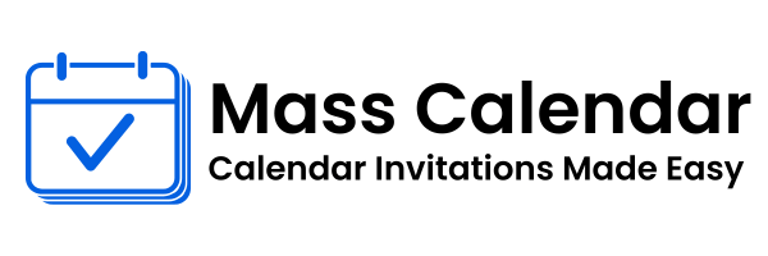Mastering Large-Scale Calendar Management for Teams and Organizations
Efficient scheduling is one of the most underestimated drivers of productivity in modern organizations. With teams spread across cities, countries, and continents, the need for seamless calendar coordination is greater than ever. Whether you're planning a company-wide town hall, recurring stakeholder syncs, or customer onboarding webinars, mastering mass calendar invites in Google or Outlook becomes essential to ensuring success.
BLOG
8/5/20253 min read


Efficient scheduling is one of the most underestimated drivers of productivity in modern organizations. With teams spread across cities, countries, and continents, the need for seamless calendar coordination is greater than ever. Whether you're planning a company-wide town hall, recurring stakeholder syncs, or customer onboarding webinars, mastering mass calendar invites in Google or Outlook becomes essential to ensuring success.
The key lies not just in sending invites, but in managing volume without chaos which is where organized calendar practices come into play.
Why Calendar Organization Matters at Scale
When you manage meetings for more than just a handful of people, the calendar becomes a strategic asset. Managing a mass calendar invite in Gmail or Outlook is no longer just an admin task; it directly affects attendance, engagement, and meeting outcomes.
A poorly scheduled meeting can lead to:
Missed deadlines
Decreased turnout
Confusion over time zones
Overloaded calendars and burnout
But when done right, good calendar management can streamline decision-making, improve collaboration, and free up time for actual work.
Key Elements of High-Volume Meeting Scheduling
1. Clear Communication in Every Invite
The first rule of sending calendar invites at scale is clarity. Every invite should answer these questions:
Why am I being invited?
When and where is the meeting?
What do I need to prepare?
Providing a detailed agenda, dial-in links, and contact person for questions can significantly reduce the back-and-forth before the meeting.
2. Smart Group Segmentation
Before you send bulk meeting invites in Outlook, consider breaking down your audience into subgroups:
Internal vs external attendees
Teams based on time zones
Mandatory vs optional participants
This allows for targeted communication and helps avoid clogging up calendars unnecessarily.
Scheduling Tactics for Gmail, Outlook, and Beyond
While different platforms offer different methods for managing group scheduling, the principles remain the same:
For Gmail Users:
Using Google Calendar to send mass meeting invites in Outlook or Gmail allows for:
Real-time availability checks
Automatic timezone adjustment
Easy link embedding for meetings
RSVP collection and reminders
You can also set up recurring schedules and use color-coded calendars to organize different types of meetings.
For Outlook Users:
To send bulk meeting invites in Outlook, take advantage of:
Distribution lists
Scheduling Assistant to avoid conflicts
Category tags to organize meetings
Responses tracking for large audiences
These features help streamline scheduling for teams with complex needs or strict calendar protocols.
Best Practices to Avoid Calendar Fatigue
When managing a bulk calendar, the volume of invites can easily lead to “calendar fatigue,” where team members begin to ignore or overlook important meetings. To prevent this:
Avoid sending back-to-back invites
Leave buffer time between meetings
Establish “no-meeting” blocks company-wide
Use calendar descriptions, not just titles, for context
Also, consider consolidating smaller updates into fewer, more structured sessions to minimize meeting load.
Managing Changes and Updates Smoothly
In high-volume scheduling, changes are inevitable. Reschedules, cancellations, and agenda changes happen and need to be communicated clearly.
Always send updated invites promptly.
Use consistent language like “UPDATED” or “RESCHEDULED” in subject lines.
Keep original meeting links and times in the body of emails for clarity.
This approach is especially useful when managing mass calendar invites in Google, where team members may already be juggling dozens of other meetings.
The Role of Follow-Ups and Attendance Monitoring
Just because an invite is accepted doesn’t guarantee attendance. Use calendar systems that allow you to monitor RSVP statuses, and always consider sending a follow-up email a day before important meetings. This simple step can drastically increase turnout and engagement.
When you send mass meeting invite in Outlook, the “Tracking” tab can be used to see who accepted, declined, or hasn’t responded helping organizers plan accordingly.
Final Thoughts: Bringing Order to Calendar Chaos
The ability to schedule, manage, and track high-volume meetings is now a vital skill in any workplace. Whether you're handling weekly team meetings, quarterly reviews, or multi-region training sessions, staying organized can save hours of coordination effort.
When you're working with large teams or customer-facing schedules, simple practices like using clear calendar invites, managing attendee segments, and respecting time zones can turn scheduling from a stressor into a strength.
In short, a well-managed bulk calendar helps reduce friction, improve communication, and make your organization more agile.
MassCalendar.in
Send Bulk & Mass Calendar Invites Instantly
CONTACT
Meetings
+44 (0) 203 916 5117
© 2025. All rights reserved.
Help?
